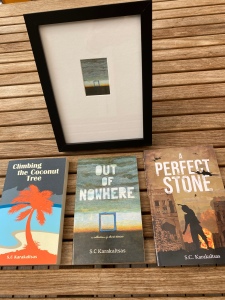Bruce Pascoe, in Dark Emu has conducted a thorough research into the evidence by a host of sources to refute what was taught to me in school and what most Australians believed. And that is, we were under the impression that Aboriginal people were nomadic hunter gatherers. Pascoe turns this on its head to explain that Aboriginal people had their own villages with well-constructed huts, dams and water traps, toiled the land, grew crops and enjoyed a fair political system. Not only that, Pascoe convincingly argues that Aboriginal history is rich and is all around us, if we only care to look for it.
“We’ve been taught that Aboriginal peoples arrived in Australia after crossing land bridges from Indonesia. … it was assumed that this happened 10000 years before sea levels began to rise – after the Ice Age. After the introduction of carbon dating, that figure ballooned to 40000 years and, after further research using more modern dating techniques, to 60000 years.”
Each chapter produces a raft of research and evidence to challenge the colonialist way of thinking of what happened before. Of course, the argument that Aboriginals were nomadic suited the colonialists as it gave them the opportunity to acquire the land – after all, in their minds, no-one else had ties to it.
Pascoe gives us evidence of advanced aqua cultural practices from sophisticated eel traps to sustainable fisheries. A few months ago, I went with friends to the Budj Bim National Park half way between Hamilton and Port Fairy in Victoria and was awestruck by the historic significance of the eel traps. What many Australians may not know is that Budj Bim is now on the UNESCO World Heritage List and features the earliest living example of aquaculture in the world. Simply astounding. In Australia there has been very little fanfare about this significant announcement. The Roman empire ruins across Europe has nothing on aboriginal culture.
The chapter around Fire was particularly enlightening as more than one hundred and fifty fires rage across Australia at the time of writing, causing untold damage to houses, people and millions of animals and plant life. I wonder if we had listened and to our Indigenous citizens whether we could have managed to ease the current disaster in any way.
“The Aboriginal approach to fire worked on five principles. One, the majority of the agricultural lands were fired on a rotating mosaic, which controlled intensity, and allowed plants and animals to survive in refuges. Two, the time of the year when fires were lit depended on the type of country to be burnt and the condition of the bush at the time. Three, the prevailing weather was crucial to the timing of the burn. Four, neighbouring clans were advised of all fire activity. Five, the growing season of particular plants was avoided at all costs.”
In fact, this has been discussed many times over the last few years yet action and further investigation has been slow. https://www.abc.net.au/news/2019-11-14/traditional-owners-predicted-bushfire-disaster/11700320
It’s natural to look for a scapegoat in the current bush-fire disaster which sees little end in sight until rain begins to fall. Climate change, land mismanagement, lack of funding, lack of leadership by our paid politicians, the drought, all have a part to play. But if what we learn takes into account a respectful dialogue with our Aboriginal elders then we may actually fix up our mistakes and change our thinking for a better future.
“If we could reform our view of how Aboriginal people were managing the national economy prior to colonisation, it might lead us to inform the ways we currently use resources and care for the land. Imagine turning our focus to the exploitation of meat-producing animals indigenous to this country. Imagine freeing ourselves from the overuse of superphosphates, herbicides and drenches. Envisage freeing ourselves from the need of fences, and instead experimenting with grazing indigenous animals and growing indigenous crops.”
Yes! My imagination is wild with possibilities and ideas. And so, this book serves as a timely message to all of us and as I peer around my own garden, I’ve started to question why the hell I have a water-sucking English style garden of roses, lawn and hedges and ponder about what was here before.
Dark Emu is sobering to read yet provides a hopeful argument for each of us to change our thinking. This is an important one for all Australians to read.
NOTE: Bush Fire Fundraiser
I’m participating in a fundraising effort for our firefighters. It’s a twitter auction involving hundreds of Australian authors. Incredible items are being auctioned -from signed books, writing retreats, mentoring, workshops etc. If you’d like to know more head over to the webpage below and if you have a twitter account, type in#authorsforfireys and make a bid.
Get in quick. The twitter auction ends 11pm on 11 January, 2020 (Melbourne/Sydney time)
I have offered up signed copies of my three books and am throwing in a framed original drawing used for the cover of Out of Nowhere.



A thought provoking review!
LikeLiked by 1 person
Thank you. It’s certainly a thought provoking book. Can’t stop thinking about it.
LikeLiked by 1 person
This was an amazing review and what an amazing read to get people thinking.One I have taken note of.
Great work with helping raise money, and reminding us that working together is the only way forward.
LikeLiked by 1 person
Thanks so much. It’s an eye-opener and definitely thought provoking.
LikeLike